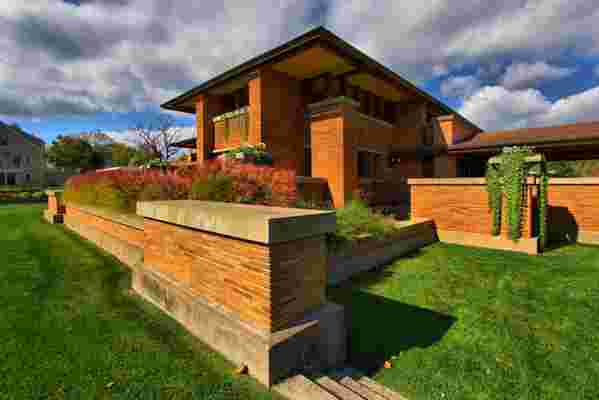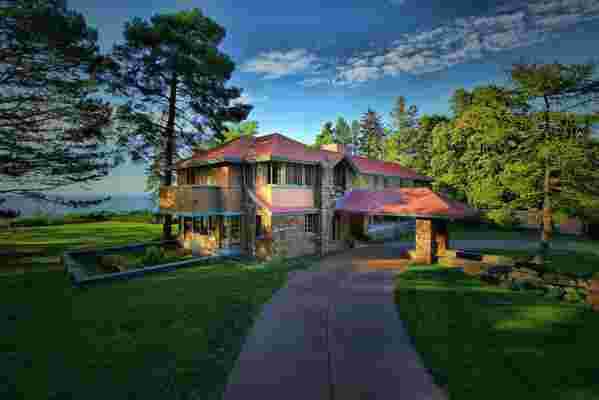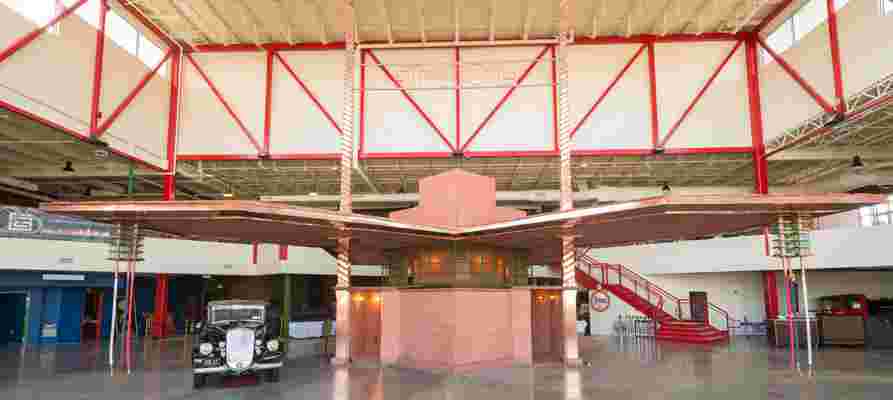The population of Buffalo, New York, may hover around 250,000 today, but at the turn of 20th century this city on Lake Erie was a major urban hub. Indeed, over a hundred years ago, as an industrial port for shipping and manufacturing, Buffalo was also the country’s eighth most populated city. And in 1901 this town snug on the Canadian border had more millionaires per capita than any other city in America.
Enter Frank Lloyd Wright, whose Queen City clients included Isabel and Darwin Martin, secretary of the legendary Larkin Soap Factory (equivalent to the modern-day Walmart). Not only did they commission two residential projects but Wright also designed the factory’s iconic Larkin Administration Building. While that perished in 1950, the two estates—plus three posthumously constructed projects based on Wright’s designs—are open to visitors. The darling of Buffalo—the Martin House Complex—unveiled a major restoration earlier this summer. “This is the most comprehensive, extensive, and expensive restoration of any Frank Lloyd Wright building in America,” says Mary Roberts, its executive director.
While Wisconsin and Arizona are the locations typically associated with Wright's work, it's in Buffalo, of all places, that architecture enthusiasts can find a plethora of his work. Below, AD runs through the list of buildings throughout the city that need to be must-sees for anyone visiting.

The Martin House
Wedged between historic homes in the Parkside neighborhood, the 15,000-square-foot, eight-bedroom Martin House —plus the Gardener’s Cottage and a home built for Darwin’s sister and brother-in-law—sits on a one-acre lot. Built between 1903 and 1905, the $52 million renovation spanned 27 years (well worth the wait) and included revamped, true-to-the-period landscaping. Consistent with Wright’s prairie style, “Tree of Life” stained-glass windows, a mosaic-tile double-sided fireplace, 24 of Wright’s Japanese color woodblock prints, and a conservatory are within, with garden views from every room. Wright designed 55 furnishings for the home—today all but five are originals. Now owned by the Martin House Restoration Corporation after being vacant between 1937 and 1967, then owned by an architect and the University of Buffalo, tours include one at twilight as well as a landscape-focused one to go deeper with the architecture. The Toshiki Moro-designed, glass-walled Greatbatch Pavilion and visitors center opened in 2009 and marries mod with minimalism, hosting the occasional yoga class.

Graycliff
When outdoor temperatures turned unbearable, and before the popularity of air conditioning, the wealthy—including the aforementioned Martins—fled to summer homes in nearby Derby, overlooking Lake Erie. Dubbed Graycliff because of a shale wall on the bluff below, and the diamond-shaped windows—a result of Wright’s observation that they fell off in diamonds—the estate built between 1926 and 1929 offers three different interior tours plus occasional garden-to-table dinners and artisan markets. Before it was bought by the Graycliff Conservancy, Hungarian priests took up residence at the estate between the 1950s and late 1990s. Last fall, Graycliff completed a 20-year restoration focused on key tenets of its organic architecture: ribbons of windows, cantilevered balconies and sun porches, plus updating landscaping done by celebrated landscape architect Ellen Biddle Shipman.

Buffalo Filling Station
Among Wright’s lesser known designs is a filling station commissioned in 1927 for downtown Buffalo, with wow-factor amenities like two fireplaces (including one in the attendant’s quarters), two 45-foot “totem” poles, lavish baths (important, as women were just now starting to drive) and a copper roof. Jim Sandoro, owner of Buffalo Transportation Pierce-Arrow Museum , bought rights to the drawings for $175,000 from Taliesin and commissioned architect Patrick Mahoney to execute it. Unveiled in 2012, it’s intentionally located inside the 177,000-square-foot museum, surrounded by exquisite restored vintage cars worth millions, so as not to endure weather damage. Awash in Wright’s signature Cherokee-red-meets-mauve hue, it also boasts a second-story “observation room” where customers waited for their vehicles to be repaired.
Fontana Boathouse
Initially commissioned by the University of Wisconsin’s rowing team—but never executed in Madison, as the students couldn’t raise enough funds to build it—the Fontana Boathouse was constructed in 2007 along the Niagara River. It may be miles from Madison, but it’s still linked to the aquatic sport. Now used by a local rowing team, and rented out for private events, including in its Club Room, the rowing clubhouse is folded into a waterfront “Intro to Canalside” tour hosted by Explore Buffalo . Restoration over the past 12 years has largely focused on river-facing windows, crafted from oak, a consistent wood in Wright’s designs.
Blue Sky Mausoleum
Tucked into Delaware Park—designed by Frederick Law Olmsted and home to Forest Lawn Cemetery, where you’ll find the highest hills in Buffalo (more like gentle slopes)— this mausoleum was constructed in 2004 based on Wright’s 1928 design. It was commissioned by Darwin Martin to be a final resting place for his family. The architect, Anthony Puttnam, served as an apprentice to Wright and also was tasked with building the Monona Terrace in Madison, another posthumous design of Wright’s. A quote from Wright (“a burial facing the open sky…the whole could not fail of noble effect,” culled from a letter he wrote to Martin about the project) adorns a monolith, while broad stairs are arranged in a gradual step design.
